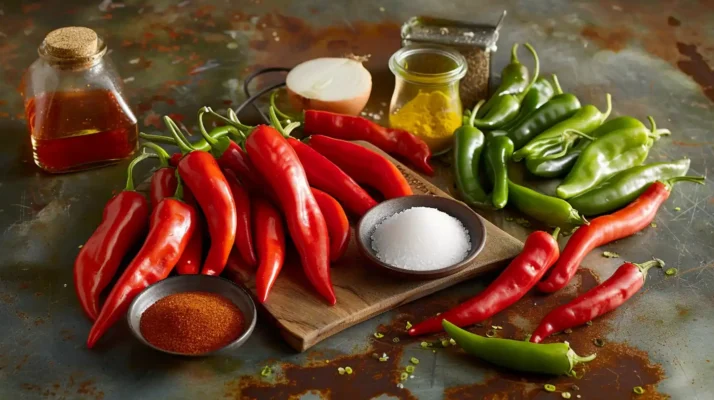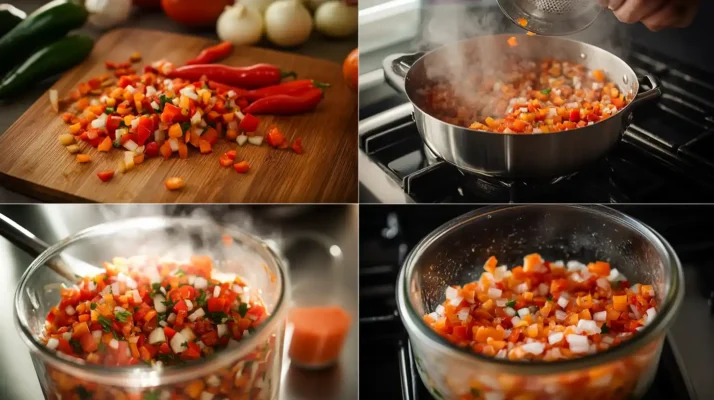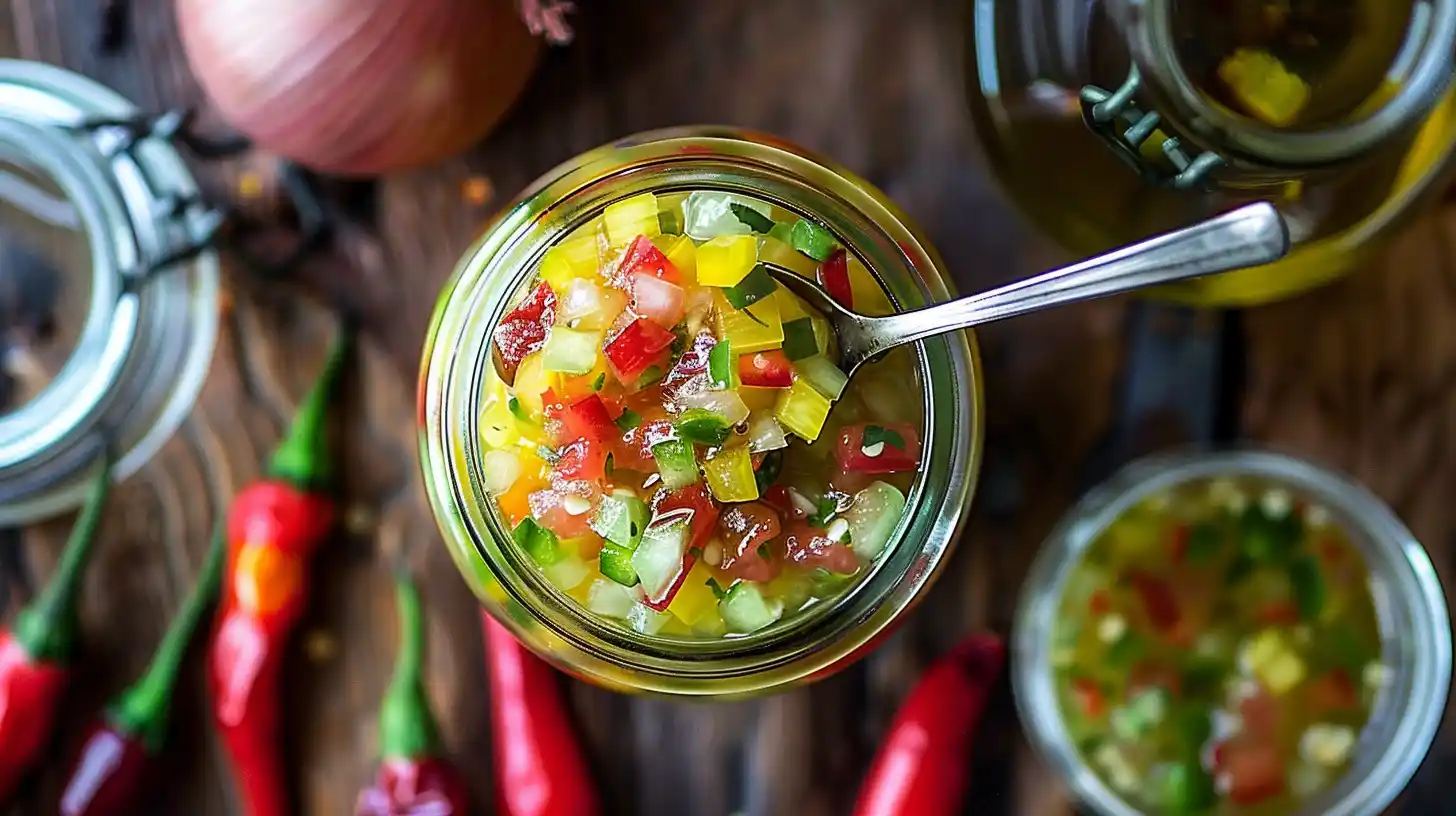This guide teaches you how to make delicious hot pepper relish, a flavorful condiment perfect for adding a spicy kick to your meals. We’ll cover the ingredients, their roles, different recipe variations, and step-by-step instructions. We’ll also explain the importance of choosing the right peppers and safe handling techniques.
Table of Contents
Understanding Hot Peppers: Types and Heat Levels
Popular Pepper Types
Jalapeños have a mild to medium heat. Serranos are hotter than jalapeños. Habaneros bring a lot of heat. Other varieties of peppers are available, each with its own temperature and flavor.
The Scoville Scale
The Scoville scale measures a pepper’s heat. A higher number means more heat. Jalapeños score lower than habaneros on this scale.
Choosing Peppers for Relish
Think about how spicy you want your relish. Mild peppers like jalapeños make a less spicy relish. Hotter peppers, like habaneros, make a much spicier relish. The type of pepper you choose changes the relish’s flavor. Some peppers are fruity; others are more grassy. Experiment to find your favorite flavor combination!
Essential Ingredients: Beyond the Peppers

Onions: Adding Sweetness and Flavor
Onions add a sweet and savory taste to your relish and give it a nice texture. White onions are common, but red onions add a sharper flavor.
Vinegar: The Tangy Touch
Vinegar gives relish to its tangy taste. Apple cider vinegar offers a sweeter, fruitier flavor, while white vinegar provides a sharper, more acidic taste. Experiment to see which you prefer!
Sugar: Balancing the Heat
Sugar balances the heat from the peppers. Granulated sugar is typical, but brown sugar adds a more profound, molasses-like flavor. The amount of sugar you use affects how sweet and spicy your relish is.
Salt: Enhancing the Taste
Salt enhances the flavor of of the ingredients. It also helps preserve the relish.
Spices: A Flavor Boost
Spices add extra flavor and complexity. Common spices include cumin, coriander, and even some red pepper flakes for additional heat. Experiment with different spice combinations to create your unique relish!
Preparing the Peppers: Cleaning and Chopping
Cleaning Hot Peppers Safely
Wash your hands thoroughly before you start. Put on food-safe gloves to protect your skin. Do not touch your face or eyes while handling peppers. Clean the peppers under cold water. Cut off the stem.
Chopping Techniques
Dicing: Cut the peppers into small, even cubes. This method ensures even heat distribution in your relish.
Mincing: Chop the peppers into tiny pieces. This makes the relish spicier and gives it a smoother texture. Use a sharp knife for both.
Avoiding Cross-Contamination
Use separate cutting boards and knives for your peppers, especially if you prepare other foods. This prevents the pepper’s heat from transferring to different ingredients and keeps things safe.
Ingredients for Hot Pepper Relish Recipe
| Ingredients | Quantity | Note |
|---|---|---|
| Hot Peppers (Jalapeños, Serranos, Habaneros, etc.) | Variable, based on desired heat | Choose peppers based on your preferred spice level. |
| Onions | 1 medium | White or red onions work well. |
| Vinager | 1/2 cup | Apple cider or white vinager. |
| Sugar | 1/4 cup | Granulated or brown sugar. |
| Salt | 1 teaspoon | To enhance flavor and preserve the relish. |
| Spices (cumin, coriander, red pepper flakes, etc.) | To taste | Experiment with different spice combinations. |
Cooking the Relish: Simmering and Sterilizing
Simmering the Relish
Mix all the ingredients into a big pot. The mixture should come to a simmer over moderate-high temperatures. Reduce the heat to a simmer and allow it to simmer for a while.. Simmering time depends on how thick you want your relish. For a thicker relish, simmer longer—about 15-20 minutes. Stir occasionally to prevent sticking and burning. The relish is done when it thickens to your liking.
Sterilizing Jars for Safe Relish Preservation
Clean your lids and jars thoroughly using hot, soapy water. Rinse them well. Cover the lids and jars in a large pan of water. Let the water come to a simmer and allow the water to boil for at most 10 minutes. This kills any bacteria that could spoil your relish. Use tongs to gently remove hot jars as well as lids from boiling water. Let them air dry thoroughly before filling them with the relish. This prevents bacteria from growing in your homemade relish and keeps it safe to eat.

Preserving Your Relish: Canning and Storage
Water Bath Canning for Long-Term Storage
Water bath canning is a safe way to keep your relish for a long time. The first step is to sterilize the lids and jars you use by boiling the lids in water for about 10 minutes. This kills any harmful bacteria. Next, carefully fill the sterilized jars with your cooled relish, leaving about ½ inch of space at the top. Wipe the jar rims clean.
Then, put on the lids and screw on the ring’s fingertip tight. Place the filled jars in a large pot covered with water, making sure the water covers the jars by at least an inch. Boil the jars for 10 minutes.Within 10 minutes gently remove the jars, and allow them to cool completely. You will hear an “pop” sound as the jars are sealed. If properly canned, relish can last for up to a year in an area that is cool and dark.
Refrigerator Storage for Shorter-Term Use
If you don’t want to can your relish, you can store it in the refrigerator. Pour your cooled relish into clean jars or containers. Make sure the relish is completely cooled before putting it in the fridge. This prevents condensation, which can make your relish watery. Keep the relish in the refrigerator for up to two weeks. Always make sure the relish is wholly cooled before refrigerating to avoid condensation.
Flavor Variations: Sweet, Spicy, and More
Adjusting Sweetness
Want a sweeter relish? Add honey or maple syrup. Honey gives a floral sweetness, while maple syrup adds a richer, more complex taste. Begin with a small amount and then increase according to your preference. Sugar can be overwhelming and overpower any other flavours.
Adding More Spice
Add more hot peppers or a pinch of red pepper flakes for extra heat. Cumin adds an earthy flavor, while coriander provides a citrusy note. Explore different spice combinations until you have your ideal blend.
Vegetable Variations
You can add other vegetables besides onions. Diced carrots add a little sweetness and crunch. Celery adds a fresh, slightly bitter taste that complements the peppers. Remember to chop all vegetables to a similar size for even cooking. Adding vegetables changes the relish’s texture and adds more nutrients.
Serving Suggestions: Ways to Enjoy Your Relish
Relish with Sandwiches and Burgers
Spread your hot pepper relish on sandwiches or burgers for a tasty kick. It pairs well with beef, chicken, or veggie burgers.
Relish as a Condiment
Use your relish as a topping for tacos, burritos, or hot dogs. A spoonful adds extra flavor and spice.
Relish with Eggs
Try your relish with scrambled eggs or an omelet for a spicy breakfast. The relish’s acidity cuts through the richness of the eggs.
Relish with Grilled Meats
Spoon your relish onto grilled chicken, fish, or beef. The heat of the relish complements the char of the grill.
Relish in Dips and Sauces
Mix relish into dips like sour cream or guacamole for an extra zing. For a spicy twist, add it to BBQ sauces.
Relish with Cheese and Crackers
Your relish adds a spicy contrast to the creamy flavors of soft cheeses. Serve it with crackers or bread for a simple appetizer.
Relish in Salads
Add a tablespoon of relish to your favorite salad for a surprising flavor. It’s outstanding in corn or black bean salads.
Relish with Vegetables
Try your relish as a side for roasted or grilled vegetables. The relish adds a tangy sweetness to balance the vegetables’ natural flavors.
Troubleshooting Common Issues
Watery Relish
If your relish is too watery, you likely simmered it too quickly. Simmer the relish longer to allow more liquid to evaporate. Ensure your jars are completely dry before adding the relish to prevent extra moisture.
Inconsistent Texture
Uneven chopping of your ingredients can cause a bumpy texture. Make sure to chop everything into similarly sized pieces for even cooking. Over-simmering can also make the relish too soft.
Relish Not Thickening
If your relish isn’t thickening, you may need to simmer it longer. The amount of sugar and vinegar can also affect thickness. A higher sugar content might help. Constantly stir occasionally to prevent sticking. If you’re looking for a heartier dish with thick, rich consistency, check out this Low Sodium Chili Recipe for inspiration.
Relish Spoiling
If your relish spoils, it might be due to improper canning or storage. Follow the sterilization steps carefully and store your relish in a cool, dark place. Refrigerated relish should be used within two weeks.
Frequently Asked Questions
How spicy will my relish be?
The spiciness depends on the peppers you choose. Mild peppers like jalapeños make a milder relish. Habaneros will make it much spicier.
What kind of vinegar should I use?
Apple cider vinegar has a sweeter taste, while white vinegar has a sharper flavor. Experiment to find your favorite!
How long will my relish last?
If you can do it properly, your relish can last over a year. If you store it in the refrigerator, use it within two weeks.
Can I add other vegetables?
Yes! Carrots and celery are good additions. Just chop them to a similar size as the peppers and onions.
What if my relish is too watery?
You may not have simmered it long enough. Simmer it longer to let more liquid evaporate.
Making and Storing Your Relish
Safe Canning Methods
Canning your relish keeps it fresh for a long time. First, clean your jars and lids well. Then, boil them in water for ten minutes to kill any germs. Fill the hot, clean jars with your cooled relish, leaving some space at the top. Put on the lids and rings. Boil the filled jars in water for another ten minutes. Let them cool. You’ll hear a popping sound when they seal—store sealed jars in a cool, dark place.
Refrigerator Storage
If you don’t want to can, store your relish in the fridge. Use clean jars or containers. Let the relish cool entirely before putting it in the refrigerator. This prevents extra water from forming. Your relish will last about two weeks in the fridge.
This guide will help you create a delicious and flavorful hot pepper relish. Remember to prioritize safety and enjoy the process!
